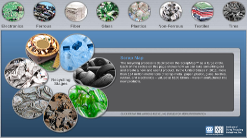DEV VERS - What’s Inside
Many of the things we use every day are made of many kinds of parts. To recycle them, we must first take them apart and figure out what's inside.
Resource Title:
What's Inside
Description:
Many of the things we use every day are made of many kinds of parts. To recycle them, we must first take them apart and figure out what's inside.
Target Grade Level:
Grades 5-8
Discipline or Course (Audience):
Science
Time Frame:
Two to three 45-minute class periods without extensions
Suggested Grouping:
3-4 students
Educator Prep:
Preparation Directions:
- Gather materials.
- Prepare Supporting Material - Student Activity Pages: What's Inside? (printable PDF)
- Collect a variety of old or broken toys or electronic devices that contain a variety of materials. Consider sending a note home to parents asking families to turn in their old, unwanted toys and/or electronic devices. You may need to specify that the items need to be relatively small (wind-up toys, toy phones, electronic toys like small electric pianos, or child-size computer-like games; old cell phones, etc.). Other items are at your discretion depending how large and complicated you are willing to get!
- If possible, enlist parent or other adult volunteers to help out on the day of dissecting the devices. This is very helpful for logistics and safety.
- Collect at least one larger, familiar object that can be disassembled, like a clock or toaster. Prepare it in advance so that you can easily open it up and show students the mechanisms inside. You’ll want to be sure you can actually take the item apart in a relatively short amount of time and with some ease (you don’t want to be struggling with it while your students get antsy or lose interest).
- Prepare a large sorting sheet for demonstration purposes. You can construct this on 11 x 17 paper, chart paper, or poster board. Categories should be: magnetic metal, non-magnetic metal, plastic, other.
- Caution: It is essential that you plan ahead to prevent shattering or accidents with sharp objects. Choose items that are easy to open. If students will be expected to crack or break the outside of a plastic toy, goggles are required. If you have younger students, you may need to split the toys in advance or choose easily disassembled items. Consider a small, plastic wind-up toy which would normally include a combination of plastic and metal parts. If you use an electric device, make sure the device is unplugged and/or remove the batteries.
Remote Learning Adaptations:
This resource is appropriate for remote learning; no adaptations or modifications are necessary.
STUDENT CONTENT BELOW
A typical cell phone or computer contains steel, copper, plastic, aluminum and glass, as well as tiny amounts of silver, gold, palladium, and platinum! In 2022, the WEEE Forum estimated that over 5.3 billion mobile phones globally were expected to be discarded out of an estimated total of 16 billion phones in use worldwide. The Global E-waste Monitor finds that by 2022, the world generated 62 billion kg of e-waste, or an average of 7.8 kg per capita. Only 22.3 per cent (13.8 billion kg) of the e-waste generated was documented as properly collected and recycled. Electronic devices and toys represent a challenge to recycle because the materials that make up the items must be identified and separated. When the amounts of recyclable materials are small and mixed with others, the cost of recycling increases. To begin to understand the challenge of recycling complex devices, you will look inside simpler devices like wind-up toys and other small appliances or electronic devices. You will then think about the many ways these items might be re-used and recycled and propose a solution for disposing old cell phones and mobile devices.
Show students a simple, familiar object that has a mechanical action. It might be a larger mechanical toy, a toaster, or alarm clock. Ask students what they think is inside. Then open it up and ask students to name the materials and parts as best they can, and why they think those materials were used for those purposes (structure and function). Questions might be: “Why do you think springs are made of metal?” (They are bouncy/bend back into shape); “Why do we make some parts out of plastic?” (They are light, colorful, and easy to shape). In a wind-up toy, for example, the key that you turn might be made of metal for strength, but the gears inside might be plastic to make the toy lightweight. Use a magnet to test the metal parts to see if they are ferrous (iron) compounds. Begin sorting the pieces using the sorting sheet. You may only get to a few items for the sake of time. Depending on grade level, you might have students identify any simple machines and discuss the mechanisms.
Ask students what they should do with old or broken toys, cell phones, and or appliances from their homes when they are ready to get rid of them. Show students images of landfills found on the Internet by projecting them on the screen. Discuss that so many objects end up in the trash when they’ve reached the end of their lifetime. Ask students to share some ideas as to why this could be problematic (landfills take up lots of space; materials in the landfills begin to break down, sometimes harmful chemicals are released into the ground, water, and air). Ask students if they think any of the parts from the sample object can be re-used or recycled instead of ending up in a landfill. Have students generate ideas. What is the difficulty in recycling objects like this? (They are made from so many different materials that are hard and timely to separate and sort). How do they think the items get sorted?
Materials:
- Device with internet access
- Supporting Material - Student Activity Pages: What's Inside? (printable PDF)
- Toys and/or electronics to disassemble (1 per every team of 3-4 students)
- One common electronic appliance or toy for demonstration purposes like a toaster
- Goggles (required for safety)
- Screw drivers or table knives (blunt) and tweezers or forceps
- Large sheets of butcher paper or poster board per group to make sorting sheet
- Markers, crayons, or colored pencils
- Projector
Safety Notes:
- When using technology, engage in safe, legal, and ethical behavior; this applies to devices (hardware), application or programs (software), and interactions with others.
- Be sure to wear goggles while during this activity.
- If you use an electric device, make sure the device is unplugged and/or remove the batteries.
- Use caution when handling example objects. Follow all safety instructions given by your teacher.
Part 1: Investigate What's Inside
Conduct lab activity as instructed. Teams do not have to have the same objects. Have parent or adult volunteers help out while students are taking apart their devices.
For older students, or where appropriate, an exploration of simple machines can be included by having students consider the wheels, gears, wedges, screws, pulleys, and levers used in the toys or objects they are dissecting. Students should also look for springs and other devices that use their elasticity to store and transfer forces. These springs are usually made of ferrous metal in small toys and simple appliances, but can be made of plastics or polymers.
- In teams of 3-4, create a sorting sheet with the following labels: magnetic metal, non-magnetic metal, plastic, other. Put your team names on the top.
- Your teacher will give your team an object to disassemble. Add the name of the item to your sorting sheet. Hypothesize as to what’s inside.
- Carefully open an example object and show students the components inside. If is has electronics, they should see parts of metal, silicon, plastic, and other materials. Put on your goggles, and open up your object as instructed by your teacher. Remove and classify the parts by placing them into the appropriate categories onto your sorting sheets. Use a magnet to help identify some of the parts as needed. List some of the structures and functions you see. Why were certain materials used?
- Take a “gallery walk” around the room to view the different objects and sorting sheets. What items did you see during the gallery walk? Could anything that could be re-used or recycled, and what are the challenges? Give adequate time for students to do a “gallery walk” around the room to view the different objects and sorting sheets. Challenge students to generate ideas and create a class list of what the class should now do with these items and/ or their parts. What items did they see during the gallery walk? Anything that could be re-used or recycled? Discuss the difficulty of recycling toys and electronics (like cell phones), and other objects because they are made up of so many different materials. In the end, all those different materials must be sorted to be recycled and reused properly. Preliminary list of ideas might include: donating devices that are still usable; bringing objects to recycling centers; making art from recycled items; etc.
- Create a list of how you think these toys or electronic devices could be disposed of in an environmentally responsible way. Show students some images of “Trash Art” (do an Internet search) and products made from recycled metals and plastics. Discuss benefits to the environment, such as less energy to make new products from recycled materials than from raw materials; less impact on Earth’s natural resources and less need to extract raw materials; some ores that are used to make electronics are only found in a few sensitive habitats on Earth; saving landfill space. You might also show Game - Scrap Map Interactive .
Part 2: Propose a Solution
Experts believe that every six months our technology doubles! According to the U.S. Environmental Protection Agency (EPA), as of 2018, 2.7 million tons of "selected consumer electronics" (TVs, phones, computer peripherals) were generated per year, with a recycling rate of 38.5%, and the rest either landfilled or sent for energy recovery. Challenge students to conduct research on their own about how to responsibly dispose of old electronic devices like cell phones and other mobile devices.
- Conduct some research on your own to find out how old electronic devices like cell phones can be disposed of properly. Evaluate the websites you visit to be sure they are presenting reliable information, and list these. In your teams, prepare to give a 5-minute presentation that:
- Discusses the negative impacts of throwing electronic devices into the trash.
- Presents at least 2-3 options for properly disposing of cell phones or other mobile devices.
- Discusses the benefits associated with the options presented in B.
- Makes an argument for what you think the best solution is and why.
- Create a class plan for re-using or recycling the items used during this lab! Facilitate class discussion about how items used for the lab activity should be disposed of and have students take part in preparing the items for recycling. This could include setting aside some of the items to make trash art, collecting all metals together and recycling, collecting plastics all together and recycling, putting anything that still works back together and donating. If any electronic devices like old cell phones were used, methods proposed by students during their presentations should be used.
Reflect and Apply:
- Why are certain materials used in toys and electronics?
- What are some of the challenges in recycling these items?
- Propose at least 2 ways items like these can either be re-used or recycled.
- What do you think people should do with their old cell phones and why? Recommendations should be based on evidence and research, and they should be able to explain the benefits to the environment.
Extension:
- You design it! Take a look at images of “Trash Art”, and other creations made from recyclable materials. Using some of the materials you used from the lab, or other items you collect from friends or at home, create a new use for an old item. This could be a work of art or a new device with a new function. Be creative!
- Journal Question: How would you design a plan to get your whole community involved in recycling old toys and electronic devices?





